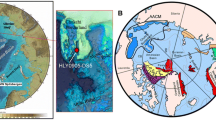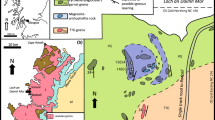Abstract
An investigation of U-Pb isotopic systematics in zircons from mylonitized Henderson Gneiss (Sinha and Glover 1978) revealed that selected zircon fractions from the mylonite zone suffered total loss of radiogenic Pb at ∼ 460 m.y. To further investigate the relationship between Pb loss, U gain, and grain size reduction associated with increasing strain in the shear zone, we have characterized the chemistry and morphology of zircons in the mylonitic rocks, using both electron microprobe analysis and scanning electron microscopy.
SEM photographs of the zircons indicate that strain-correlated fracturing and size reduction of the zircons accompanied Pb loss throughout the mylonite zone. Stresses imposed by the expansion of initially U-rich, α-damaged portions of the crystal resulted in microfracturing of the more brittle crystalline material proximal to the U-rich zones. During mylonitization, fractures propagated preferentially along these zones allowing metamorphic fluids to penetrate the easily-leached, α-damaged portions of the zircons. Removal of ∼75% of the radiogenic Pb from zircons in the least-deformed zone of the mylonites may have occurred via this mechanism.
Irregular, porous zircon overgrowths are also evident from the SEM photographs. Overgrowths are strongly enriched in U, Y and P with respect to the relict, Henderson Gneiss-derived cores, and tend to increase in volume from the protomylonite to the blastomylonite. Thus, the development of overgrowths on the zircons accounts for the U gain observed by Sinha and Glover (1978), and indicates that the transport of high field strength cations (e.g., Zr4+, Hf4+, U4+, etc.) occurred during prograde mylonitization at 460 m.y.
A retrograde shearing event at ∼ 273 m.y. caused no further disturbance in the U-Pb isotopic systematics of the zircons. Pb retention by zircons during the later episode may have been the result of 1) the participation of H2O-rich, relatively noncorrosive fluids and/or 2) the lack of further fracturing and size reduction in a strain gradient of lower magnitude than the prograde event.
Similar content being viewed by others
References
Åberg G, Bollmark B (1985) Retention of U and Pb in zircons from shocked granite in the Siljan impact structure, Sweden. Earth Planet Sci Lett 74:347–349
Aines RD, Rossman GR (1986) Relationships between radiation damage and trace water in zircon, quartz and topaz. Am Min 71:1186–1193
Allègre CJ, Albarède F, Grünenfelder M, Köppel V (1974) 238U/ 206Pb-235U/207Pb-232Th/208Pb zircon geochronology in Alpine and non-Alpine environments. Contrib Mineral Petrol 43:163–194
Bence AE, Albee AL (1968) Empirical correction factors for the electron microanalysis of silicates and oxides. J Geol 76:382–403
Bickford ME, Chase RB, Nelson BK, Shuster RD, Arruda EC (1981) U-Pb studies of zircon cores and overgrowths and monazite: implications for age and petrogenesis of the northeastern Idaho Batholith. J Geol 89:433–457
Boullier AM (1980) A preliminary study on the behavior of brittle minerals in a ductile matrix: example of zircons and feldspars. J Struct Geol 2:211–217
Bryant B, Reed JC (1970) Geology of the Grandfather Mountain window and vicinity, North Carolina and Tennessee. US Geol Surv Prof Pap 615, 190 p
Chakoumakos BC, Murakami T, Lumpkin GR, Ewing RC (1987) Alpha-decay-induced fracturing in zircon: the transition from the crystalline to the metamict state. Science 236:1556–1559
Chase RB, Bickford ME, Arruda EC (1983) Tectonic implications of Tertiary intrusion and shearing within the Bitterroot Dome, northeastern Idaho Batholith. J Geol 91:462–470
Ewing RC, Haaker RF, Lutze W (1982) Leachability of zircon as a function of alpha dose. In: Lutze W (ed) Scientific basis for radioactive waste management V. Mat Res Soc Symp Proc 11. Elsevier, New York, pp 389–394
Gebauer D, Grünenfelder M (1976) U-Pb zircon and Rb-Sr whole rock dating of low-grade metasediments, example: Montagne Noire (Southern France). Contrib Mineral Petrol 59:13–32
Gebauer D, Bernard-Griffiths J, Grünenfelder M (1981) U-Pb zircon and monazite dating of a mafic-ultramafic complex and its country rocks. Contrib Mineral Petrol 76:292–300
Grauert B (1974) U-Pb systematics in heterogeneous zircon populations from the Precambrian basement of the Maryland Piedmont. Earth Planet Sci Eett: 238–248
Gulson BL, Krogh TE (1975) Evidence of multiple intrusion, possible resetting of U-Pb ages and new crystallization of zircons in the post-tectonic intrusions (“Rapakivi granites”) and gneisses from South Greenland. Geochim Cosmochim Acta 39:65–82
Hadley JB, Nelson AE (1971) Geologic map of the Knoxville quadrangle, North Carolina, Tennessee and South Carolina. US Geol Surv Mise Geol Investigations Map I-654, scale 1:250,000
Hart SR, Davis GL, Steiger RH, Tilton GR (1968) A comparison of the isotopic mineral age variations and petrologic changes induced by contact metamorphism. In: Hamilton EI, Farquhar RM (eds) Radiometric dating for geologists. John Wiley and Sons, New York, pp 73–110
Hatcher RD (1971) Stratigraphic, petrologic and structural evidence favoring a thrust solution to the Brevard problem. Am J Sci 270:177–202
Holland HD, Gottfried D (1955) The effect of nuclear radiation on the structure of zircon. Acta Crystallogr 8:291–300
Krogh TE, Davis GL (1975) Alteration in zircons and differential dissolution of altered and metamict zircon. Carnegie Inst Wash Yearbook 1974–1975, pp 619–625
Lancelot JR, Boullier AM, Maluski H, Ducrot J (1983) Deformation and related radiogeochronology in a Late Pan-African mylonitic shear zone, Ardrar des Ifuras (Mali). Contrib Mineral Petrol 82:312–326
Mitra G (1978) Ductile deformation zones and mylonites: the mechanical processes involved in the deformation of crystalline basement rocks. Am J Sci 278:1057–1084
Mumpton FA, Roy R (1961) Hydrothermal stability studies of the zircon-thorite group. Geochim Cosmochim Acta 21:217–238
Peterman ZE, Zartman RE, Sims PK (1980) Tonalitic gneiss of early Archean age from northern Michigan. Geol Soc Am Special Pap 182:125–134
Peterman ZE, Zartman RE, Sims PK (1986) A protracted Archean history in the Watersmeet Gneiss dome, northern Michigan. In: Peterman ZE, Schnabel DC (eds) Shorter contributions to isotope research, USGS Bull 1622:51–64
Peucat JJ, Tisserant D, Caby R, Clauer N (1985) Resistance of zircons to U-Pb resetting in a prograde metamorphic sequence of Caledonian age in East Greeland. Can J Earth Sci 22:330–338
Pidgeon RT, O'Neil JR, Silver LT (1966) Uranium and lead isotopic stability in a metamict zircon under experimental hydrothermal conditions. Science 154:1538–1540
Pidgeon RT, O'Neil RJ, Silver LT (1973) Observations on the crystallinity and the U-Pb system of a metamict Ceylon zircon under experimental hydrothermal conditions. Fortschr Mineral 50:118
Ramakrishnan SS, Gokhale KVGK, Subbarao FC (1969) Solid solubility in the system zirconhafnon. Mat Res Bull 4:323–328
Romans PA, Brown LL, White JC (1975) An electron microprobe study of yttrium, rare earth and phosphorus distribution in zoned and ordinary zircon. Am Mineral 60:475–480
Roper PJ, Dunn DE (1973) Superposed deformation and polymetamorphism, Brevard Zone, South Carolina. Geol Soc Am Bull 84:3373–3386
Schenk V (1980) U-Pb and Rb-Sr radiometric dates and their correlation with metamorphic events in the granulite-facies basement of the Serre, Southern Calabria (Italy). Contrib Mineral Petrol 73:23–38
Sinha AK, Glover III L (1978) U/Pb systematics during dynamic metamorphism, a study from the Brevard fault zone. Contrib Mineral Petrol 66:305–310
Sinha AK, Hewitt DA, Rimstidt JD (1986) Fluid interaction and element mobility in the development of ultramylonites. Geology 14:883–886
Sinha AK, Hewitt DA, Rimstidt JD (1988) Metamorphic petrology and strontium isotope geochemistry associated with the development of mylonites: an example from the Brevard fault zone, North Carolina. Am J Sci (in press)
Sommerauer J (1974) Trace element distribution patterns and the mineralogical stability of zircon — an application for combined electron microprobe techniques. Electron Micros Soc S Afr Proc 4:71–72
Sommerauer J (1976) Die chemisch-physikalische Stabilität natürlicher Zirkone und ihr U-(Th)-Pb System. PhD diss 5755, Swiss Fed Inst Tech, Zürich
Steiger RH, Wasserburg GJ (1966) Systematics in the Pb208-Th232, Pb207-U235, and Pb206-U238 systems. J Geophys Res 71:6065–6090
Tilton GR (1960) Volume diffusion as a mechanism for discordant lead ages. J Geophys Res 65:2933–2945
Vocke RD, Hanson GN, Grünenfelder M (1987) Rare earth element mobility in the Roffna Gneiss, Switzerland. Contrib Mineral Petrol 95:145–154
Wasserburg GJ (1963) Diffusion processes in lead-uranium systems. J Geophys Res 68:4823–4846
Watson EB (1980) Some experimentally determined zircon/liquid partition coefficients for the rare earth elements. Geochim Cosmochim Acta 44:895–897
Wayne DM, Solberg TN, Sinha AK (1987) Microprobe analysis of isotopically reset zircons from a Brevard Zone mylonite. In: Geiss R (ed) Microbeam analysis — 1987. San Francisco Press, San Francisco, pp 315–316
Wetherill GS (1956a) An interpretation of the Rhodesia and Wit-waterstrand age patterns. Geochim Cosmochim Acta 9:290–292
Wetherill GS (1956b) Discordant uranium-lead ages, I. Trans Am Geophys Union 37:320–326
Wetherill GS (1963) Discordant uranium-lead ages, II: discordant ages resulting from diffusion of lead and uranium. J Geophys Res 68:2957–2965
Author information
Authors and Affiliations
Rights and permissions
About this article
Cite this article
Wayne, D.M., Sinha, A.K. Physical and chemical response of zircons to deformation. Contr. Mineral. and Petrol. 98, 109–121 (1988). https://doi.org/10.1007/BF00371915
Received:
Accepted:
Issue Date:
DOI: https://doi.org/10.1007/BF00371915




